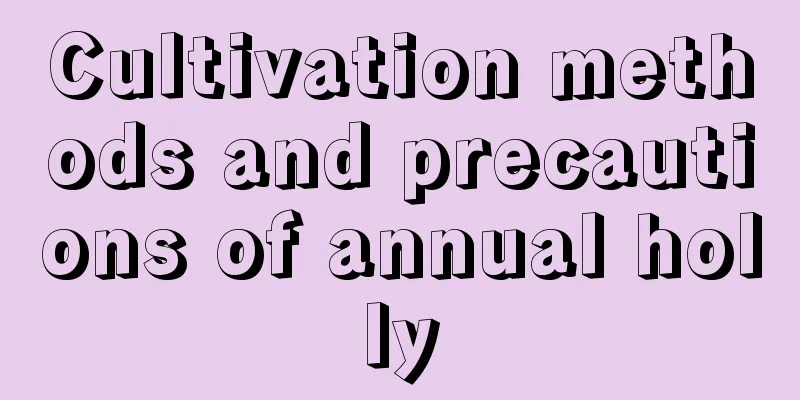Cultivation methods and precautions of annual holly

1. Maintenance methods1. Light management: During the maintenance process, you should try to give it sufficient sunlight, because it likes to grow in sunny places. 2. Substrate selection: Annual sedge is an annual or semi-annual herb with good growth ability, so it can grow in poor soil under harsh conditions. However, the soil should be fertile. 3. Nutrient management: Annual hollyhock has strong vitality and can adapt to harsh environments. It can grow normally if it is given the nutrients it needs. 4. Temperature management: This plant is not winter-resistant and the temperature needs to be kept at around 16-25 degrees Celsius all year round. Moreover, the temperature cannot change back and forth during the curing period. 2. Breeding techniques1. Summer: The temperature in summer needs to be maintained at 16-25 degrees Celsius. It needs to be cultivated outdoors, and it needs to be well ventilated and have sufficient water. 2. Reproduction: Annual fleabane reproduces by seeds, so it can be sown every year. The seeds germinate in early spring or autumn, the flowers bloom from June to August, and the fruits are produced from August to October. 3. Problem diagnosis and treatment1. Yellowing leaves: If yellowing leaves occur, it is most likely due to excessive fertilization or waterlogging. At this time, apply less fertilizer to avoid root burn, and check whether it is caused by waterlogging. If there is root rot, it should be pruned in time. 2. Root rot: When the rainy season comes in summer, waterlogging is likely to occur, leading to lack of oxygen at the roots and thus root rot. Waterproofing should be done in time, the soil should be loosened, and attention should be paid to ventilation. IV. Other issues1. Is it poisonous? Annual fleabane is a herbaceous plant. It is non-toxic and its beautiful flowers are very attractive. 2. Flowering time: The flowering time of annual fleabane is summer, that is, from June to September. Its flowering period is also very long, which is conducive to viewing. |
<<: Kudzu cultivation methods and precautions
>>: Cultivation methods and precautions of motherwort
Recommend
The difference between golden amber and cactus
The difference between golden amber ball and cact...
What soil to use for Phalaenopsis
Principle of soil use What kind of soil should be...
Diseases of Prunus aviculare and their control
Diseases of Prunus aviculare and their control Di...
How many pounds does Xanthoceras sorbifolia yield per mu?
Yield of Xanthoceras sorbifolia per mu Xanthocera...
The efficacy and function of Houttuynia cordata
1. Sterilization Houttuynia cordata contains hout...
Cultivation methods and precautions of wood butterfly
1. Maintenance methods 1. Soil: Wood butterfly li...
Is the fiddle-leaf fig suitable for the bedroom?
1. Reasons for suitability The fiddle-leaf fig ha...
How to propagate Schefflera and what to pay attention to
Schefflera propagation method The main ways of pr...
How to grow Hoya in autumn
1. Loosen the soil In autumn, it is best to use a...
How to propagate cactus from cuttings
1. Cutting time The time for cactus cuttings is v...
Why does the copper green unicorn turn into water?
1. Humid climate The copper green Kirin does not ...
How to cultivate Gypsophila paniculata
1. Choose the right soil The most important thing...
What kind of plants are good to put on the living room partition cabinet?
1. Tiger Piranha You can place snake plant on the...
Use this for cuttings, 100% rooting! It’s so easy!
Use these things to make cuttings 1. Fish tank bo...
How to care for African jasmine in winter
Is African jasmine afraid of cold? The suitable t...









